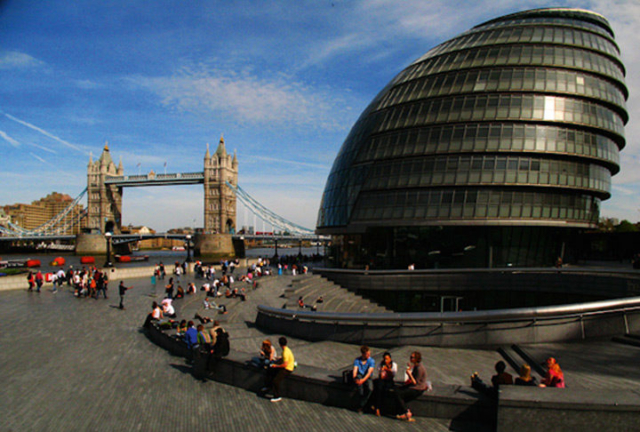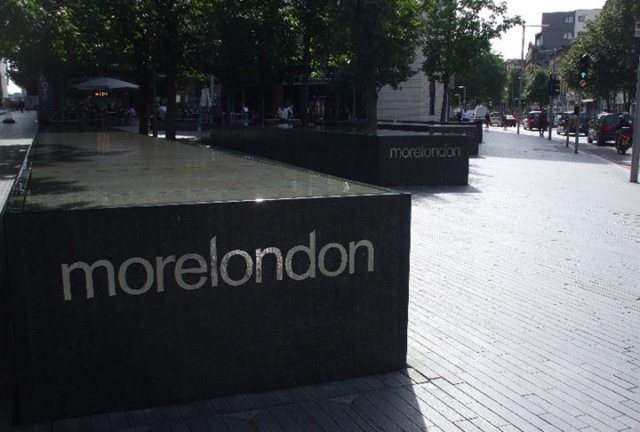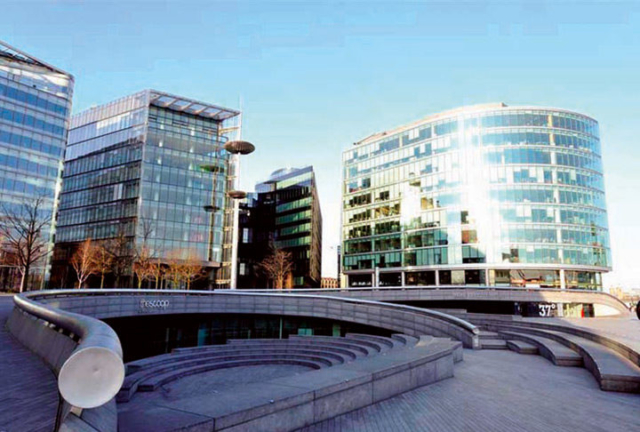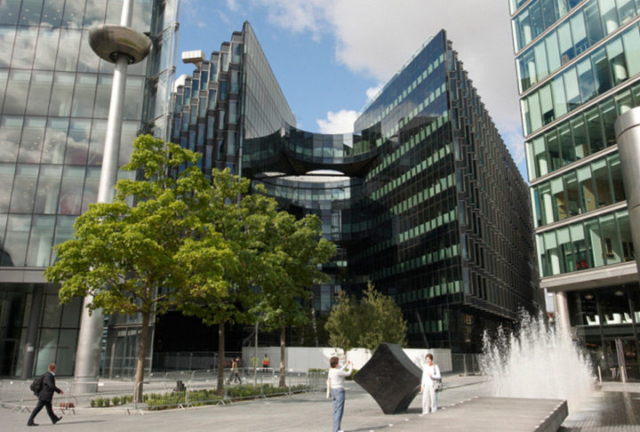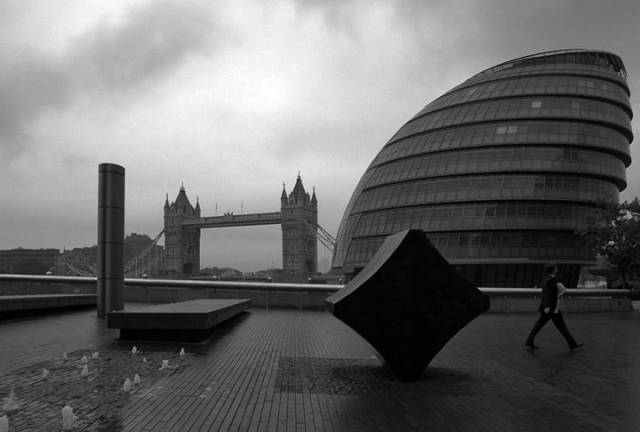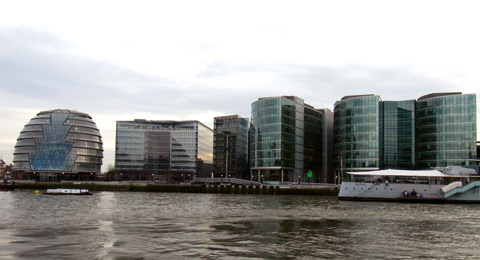Tekst: Andrej Đivuljskij
More London Riverside
Priču o revitalizaciji obale Temze u Londonu ne možemo započeti a da se ne osvrnemo na činjenicu da je London bio jedna od najvažnijih luka u svetu još od vremena Rimske imperije, kada je bio centar trgovine Britanije sa ostatkom Rimskog carstva. U vreme imperijalne ekspanzije Britanskog carstva, značaj ovog grada kao luke je bio ogroman. Međutim, u XX veku, situacija se preokrenula, i kako je opadala imperijalna moć Britanije, kako je ta pomorska, vojna i trgovačka sila gubila svoj primat na svetskom tržištu, kako se menjala lučka tehnologija, način pretovara, mehanizacija, i kako je u vodenom saobraćaju primat preuzimao prekookeanski u odnosu na rečni, tako se i industrijska obala Londona suočila sa padom aktivnosti, napuštanjem, degradacijom, a na kraju i zatvaranjem dokova tokom 1970-ih godina.[1]
[1] Costello, Kieran; Grant, Paul, London docklands: changing times, London Docklands Development Corporation, London, 1999.
[2] Malone, Patrick, City, Capital and Water, Routledge, London, 1996, str.15
[3] Ibid.
[4] http://www.fosterandpartners.com/Projects/1011/Default.aspx
[5] http://www.fosterandpartners.com/Projects/1460/Default.aspx
Inicijativa za revitalizacijom londonskih dokova potiče iz tog doba, podsticana od svake vlade. Godine 1981. je osnovana Korporacija za razvoj londonskih dokova (London Docklands Development Corporation) koja je prepustila zonu privatnim preduzetnicima bez ograničenja u vidu kontrole i taksi: „tokom 1980-ih godina je započeta nova era, kada je zona, sada poznata kao Dokovi (docklands), apsorbovala ogromne investicije razvojnog kapitala i kada je izgledalo da će to mesto postati savremen rezidencijalni i poslovni prostor.”[2] To je bio izraz novog doba kapitalistiĉke inicijative, “japija” i Tačerizma, kao i razvojnog sistema koji marginalizuje socijalne i planerske aspekte, a preferira monetarizam kao vodeću silu koja vodi urbani razvoj. Sve je to bilo zaodenuto u postmodernističko arhitektonsko ruho. Međutim, kasnih 1980-ih dolazi do propadanja tržišta nekretnina i kraja kreditnog buma, da bi “1992. godine, gigantski projekat Kenerij Vorf (Canary Wharf), najznačaniji simbol revitalizacije dokova, upao u finansijsku krizu.
Dokovi su postali noćna mora špekulanata i propadanje Kenerij Vorfa u krizu je označilo kraj snova Tačerizma.” [3] Na taj način, projekat revitalizacije londonskih Dokova je postao, u socijalnom i planerskom smislu (zbog porasta beskućništva, nezaposlenosti i negativnog uticaja na lokalno stanovništvo), negativan primer revitalizacije gradske obale, kao i osuda prepuštanju urbanog razvoja rukama privatnih investitora koji se vode sirovom i nepažljivom željom za pukim stvaranjem profita, bez aktivnog učešća grada i vlasti. Godine 1998, kontrola nad ovim prostorom je vraćena u ruke lokalnih vlasti. Danas su Dokovi najveća urbana celina pod neboderima u Evropi, i direktan konkurent centralnom delu grada (City) u finansijskom smislu. Mnogo starih skladišta na obali je srušeno, a neke su pretvorene u stambeni prostor, dok se većina dokova koristi za sportove na vodi i kao marine.
Priča o londonskim Dokovima jeste najvažnija i najobimnija priča revitalizacije londonske obale Temze, međutim, to nije sve. Tu se nalaze i takozvani “milenijumski projekti”, koje čine: “Milenijumska kupola” arhitekte Ričarda Rodžersa, kao najveća kupola tog tipa na svetu, na poluostrvu Grinič – urađena je kao deo strategije revitalizacije dela grada koji je poznat kao “Kapija Temze”, namenjena je kao glavno mesto za “Millenium Expirience” (najveća i najvažnija izložba pri dočeku i proslavi trećeg milenijuma), a danas se koristi za razne velike sportske i muzičke događaje; “Milenijumski most” arhitekte Normana Fostera, čelični, viseći most namenjen samo pešacima koji povezuje dve najveće turističke atrakcije Londona (St.Paul’s Cathedral i galerija “Tate Modern”); “Milenijumski točak” ili “Oko Londona” (London Eye), turistička atrakcija koja je Londonu donela najviše novca; kao i “Millbanks Millenium Pier”, putničko pristanište na Temzi, arhitekte Marks Barfilda, koji je takođe bio zaslužan i za “Milenijumski točak”. Već pomenuta galerija “Tate Modern”, arhitekata Hercoga i de Mejrona, kao i njihov projekat plesnog centra “Laban”, su takođe arhitektonski projekti na obali reke koji su vredni pomena.
Međutim, ime Normana Fostera i njegovog biroa “Foster+Partners” zauzima posebno mesto u celoj priči o revitalizaciji obale Londona, kao i u savremenoj arhitekturi Londona uopšte. Uz već pomenuti projekat “Milenijumskog mosta”, njegovo najvažnije delo uključeno u revitalizaciju obale Temze je objekat Gradske kuće, koja je dom Uprave Šireg Londona (Greater London Authority), i koja je deo jedne potpuno nove gradske celine koja je nedavno izgrađena pod imenom “More London Riverside”, za koju je takođe zaslužan Foster.
“More London Riverside” predstavlja novu gradsku četvrt koja se nalazi na mestu koje je decenijama bilo neiskorišćeno. Gradske funkcije kojima je ispunjena ova četvrt su bogate: kancelarijski prostor, hotel, supermarket, prodavnice, kafei, restorani, kao i novi dom za dečji teatar “Unicorn”. Ova gradska celina je u potpunosti namenjena pešacima, a kolski saobraćaj je sveden na najmanju moguću meru zahvaljujući činjenici da se u blizini nalaze važna čvorišta javnog gradskog prevoza. Više od polovine površine ove četvrti je pod javnim gradskim prostorima, koji su obogaćeni skulpturama, fontanama, kao i odgovarajućim urbanim mobilijarom za sedenje i osvetljenje. “The Scoop” je naziv za otvoreni amfiteatar koji je ukopan odmah pored Gradske kuće, i koji služi za održavanje raznovrsnih manifestacija. Ovaj prostor je najatraktivniji otvoreni prostor u ovoj gradskoj celini.
Celokupan master-plan za razvoj četvrti “More London Riveride” je sačinjen sa idejom da taj projekat bude ključni element u regeneraciji Sautvorka, četvrti Londona u kojoj se nalazi, tako što će zauzeti strateški bitno mesto na kulturnoj i turističkoj pešačkoj ruti od galerije “Tate Modern”, teatra “Globe” i katedrale Sautvork, do broda-muzeja pod imenom “HMS Belfast”. [4]
Novi objekti u ovoj gradskoj četvrti nemaju imena, već brojeve od 1 do 7. Poslednji po redu, i najveći objekat, nosi naziv “7 More London Riverside”, i udomljuje korporaciju PricewaterhouseCoopers (PwC). Objekat se odlikuje posebnom formom, ali i ekološkim standardima koje je postavio – naime, to je tek treća građevina u Ujedinjenom Kraljevstvu, a prva u Engleskoj, koja je zaslužila ocenu “natprosečno” (outstanding) po BREEAM standardima. Radi se o ekološkoj metodi ocenjivanja građevina koje nije obavezujuće, već dobrovoljno, i koje je uspostavljeno od strane Zavoda za istraživanje građevina (Buildings Research Establishment), osnovanog kao državno preduzeće, koje je danas privatno, sponzorisano od strane građevinske industrije.
Ova desetospratnica koja se prostire na 60,884m² objedinjuje širok spektar mera za smanjivanje emisije CO2, obezbeđivanje obnovljive energije (solarne panele), efikasan sistem automatskog upravljanja građevinom, zelene krovove, fasadu visokih performansi koja obezbeđuje senku i osvetljenje, kao i upotrebu betona koji se sastoji od 80% recikliranih agregata. Ključni aspekt dizajna, koji je najviše uticao na dobijanje natprosečne ekološke ocene ove građevine, jeste implementacija kombinovanog sistema za hlađenje, grejanje i snadbevanje energijom (Combined Cooling Heating & Power Trigeneration system), koji radi na bio-dizel gorivo, i koji je na taj način smanjio emisiju CO2 na količinu koja je 55% manja nego što to traže propisi iz 2006. godine. Za dizajn svih glavnih sistema za održavanje građevine je bila zadužena firma “Roger Preston&Partners”.
S obzirom na mesto ovog objekta u urbanoj matrici i njegovu vidljivost sa svih strana, posebna pažnja je data izgledu fasade, kako bi se građevini dao karakterističan izgled. Cik-cak fasada štiti enterijer od ulaska previše svetla, ali mu i dozvoljava da prodre do kancelarijskog prostora. Klapne na fasadi je oživljavaju, prelamajući i projektujući svetlo i boje unutar građevine, dok stvaraju iskričav efekat na njenoj fasadi. Kako bi se još više maksimizovalo osvetljenje građevine i pogled na okolinu iz nje, njena simetrična krila se otvaraju ka reci i otkrivaju atrijumski prostor u svom jezgru koji predstavlja unutrašnji trg za korisnike objekta, a čiji umetnički potencijal i aranžman liftova i zakrivljenih mostova oslikavaju život četvrti More London..[5]
Text: Andrej Đivuljskij
More London Riverside
A story about Thames riverside revitalization cannot commence without mentioning the importance of London harbor, dating back to the Roman Empire. In those times, London was the center of British commerce with the rest of the Empire. Later on, during the expansion of the British colonial Empire, the importance of the city and its harbor was immense. The twist comes in XX century, as the colonial power was getting weaker – the military, maritime and commercial Britannia was losing its strength in the world market and consequently the river waterways lost primacy over the overseas trade. Therefore, the London industrial docks decreased in activities, started to degrade and eventually were abandoned in seventies. [1]
[1] Costello, Kieran; Grant, Paul, London docklands: changing times, London Docklands Development Corporation, London, 1999.
[2] Malone, Patrick, City, Capital and Water, Routledge, London, 1996, str.15
[3] Ibid.
Revitalizacija obale Londona / London Riverside re-invented
[4] http://www.fosterandpartners.com/Projects/1011/Default.aspx
[5] http://www.fosterandpartners.com/Projects/1460/Default.aspx
Initiative to revitalize London docks emerged soon after, and was supported by city authorities. In 1981 a London Docklands Development Corporation was set up. The Corporation gave freedom to the private sector to start investments, without any limitations or taxes imposed; “In the eighties a new era had begun, when the area, nowadays known as Docklands, absorbed tremendous amounts of the investment funds money, and it was obvious that it will become the contemporary residential and business venue.” [2]
Such approach, clearly being the expression of the new yuppie and Thatcherism era, set to the margin social and urban planning aspects. Thus, the leading urban development aspect became monetarism, all sugar-coated in post-modern architectural robe. In the late eighties the real estate market and bank loans boom crashed, followed by a gigantic Canary Wharf project, the most important symbol of dockside revitalization, which collapsed in 1992.
The Dockside turned into a nightmare of speculators and collapse of the Canary Wharf was the end of the Thatcherism dreams.”[3]
Due to all those circumstances, the social and urban planning aspect of Dockside revitalization set a bad example. It provoked raise in the number of homeless people, high unemployment rate and negative influence to the local population. The whole project was condemned for letting solely private investors deal with the revitalization, led only by profit, without active involvement of city authorities.
In 1998, the control over the Dockside went back to the local authorities. Nowadays, the Docks are the largest urban settlement under the skyscrapers in Europe and direct competitor to the City, in financial aspect. Old warehouses have been broken down, while some have been turned into apartments. The rest of them are being used for sports and marines.
The Dockside story is by far the most important and the most extensive in the context of the Thames revitalization, however, the story does not end here. The revitalization implied the “millennium projects” – the Millennium Dome, by Richard Rogers. It is the biggest dome of its kind in the world, located on the river peninsula Greenwich. Within the revitalization project, it was a part of the “Thames Gate”, which was the venue for a celebration of the third millennium. After that, it has been used for sports and music events. The Millennium Bridge, by Norman Foster, is a steel suspension bridge, for pedestrians only, connecting two important London landmarks, St. Paul`s Cathedral and the Tate Modern. Millennium Wheel or the “London Eye” is the most profitable tourist attraction of all. Similar status holds the Millbank Millennium Pier, a dock on the Thames, by Marks Barfield, who is also the author of the Eye. Architects Herzog & de Meuron are authors of the Tate Modern, as well as the dance center Laban, architectural projects worth mentioning by all means.
However, Norman Foster and his bureau “Foster + Partners” hold a special place in the London docks revitalization, as well as in London contemporary architecture. One of his also very important works, within the Thames riverside revitalization is the City Hall project, which is the venue of the Greater London Authority, a part of a completely new urban area, built recently under the name “More London Riverside.”
“More London Riverside” is a new city area, located at a site that has been empty for decades. This part of the city is rich in business premises, hotels, markets, cafes, restaurants and in particular new theater for children, “Unicorn”. This city area is pedestrians-friendly. Vehicles are reduced to a minimum, since in the vicinity there is an important public transportation hub. More than half of the area belongs to the local authorities, who took care to decorate the public spaces with sculptures, fountains, nice and comfortable benches and lighting. Just next to the City Hall there is an open-air amphitheater, “The Scoop”, a venue for various events and by far the most attractive open-air facility in the neighborhood.
The master plan for development of the “More London Riverside” has been drafted with the premise to be the essential element in the Southwark revitalization. Being a strategically important London neighborhood, it stretches from the Tate Modern and the Globe Theatre, alongside the Southwark cathedral all the way to the HMS Belfast, an important tourist and cultural zone. [4]
New objects in this neighborhood are marked with numbers, ranging from 1 to 7. The last and the biggest one is 7, More London Riverside which is the headquarters of the PriceWaterhouseCoopers corporation. This object features a unique form and proudly presents ecology standards; namely it is the third building in the UK and the very first in England to bear the title “outstanding”, according to the BREEAM standard. This method of standardization is voluntary, not obligatory, and has been set up by the Buildings Research Establishment, initially established as a state owned enterprise, later on turned into a private corporation, financed by the construction and building industry.
This ten-stores building, surfacing 60,884m² implements whole range of measures for reduced CO2 emission, solar panels for sustainable energy, efficient system of automatic functioning, green rooftops, high-performance facade, enabling sun protection and lighting, as well as the concrete made of 80% recycled aggregates. The key element for the building to get the outstanding ecology rating is a unique combined cooling, heating & power trigeneration system. This system uses the bio-diesel fuel, thus reducing the CO2 emission to a level 55% lower than required by 2006 regulations. Design of all major maintenance systems was done by the “Roger Preston & Partners” company.
Considering the object location within the urban matrix and its visibility from all sides, particular attention has been paid to the façade appearance, so as to add a characteristic visual identity to the building. Façade valves make it lively, stretching and projecting light beams and colors in the building interior, thus creating a sparkling effect on the façade. In order to maximize the lighting effects of the building, its symmetrical wings can be opened towards the river, so as to open the atrium positioned in the center, which is at the same time an interior square for the object users, with significant artistic potential and setting of elevators and curved bridges, depicting the lively new life of the More London hood. [5]




